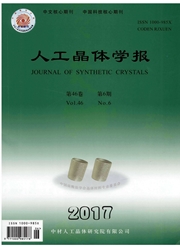

 中文摘要:
中文摘要:
使用物理气相传输方法(PVT)制备了2英寸Ti掺杂与非故意掺杂6H-SiC衬底,并对衬底进行热处理。使用拉曼光谱仪、低温光致发光谱(LTPL)和非接触电阻率测试对衬底晶型、掺杂元素和电阻率进行了表征。结果表明,Ti元素有效掺入6H-SiC中,Ti掺杂对PVT方法生长的6H-SiC衬底晶型稳定性无影响,Ti掺杂衬底与非故意掺杂衬底均为6H-SiC,热处理后Ti掺杂衬底电阻率达到1010~1011Ω·cm。初步认为Ti掺杂衬底热处理过程中产生的大浓度碳空位VC是引起Ti掺杂样品电阻率上升的主要原因。
 英文摘要:
英文摘要:
2 inch Ti doped and unintentional doped 6H-SiC substrates were fabricated by physical vapor transport(PVT) method and underwent thermal treatment. The crystal form,doping element and resistivity were characterized by Raman spectroscopic,low temperature photoluminescence(LTPL) and contact less resistivity measurement. The results show that the element Ti effectively doped in 6H-SiC during the PVT growth process,both Ti doped and unintentional doped substrates are 6H-SiC,and Ti doping has no influence on the stability of 6H-SiC crystal form. The resistivity of Ti doped SiC substrate increases more significantly than the unintentional doped substrate after thermal treatment,reach to 1010 ~ 1011Ω·cm. The large concentration of carbon vacancies(VC) generated during the thermal treatment process in the Ti doped substrate is the main reason for resistivity increases.
 同期刊论文项目
同期刊论文项目
 同项目期刊论文
同项目期刊论文
 期刊信息
期刊信息
